 About Authors:
About Authors:
Mayure.Vijay Kumar*, V. Sravanthi Yadav, C.P.Meher,
Department of pharmaceutical chemistry
Maheshwara College of Pharmacy, Chitkul (V)
Isnapur “X” Road, Patancheru, Hyderabad.
mayurevijaykumar@gmail.com
ABSTRACT:-
β- lactam antibiotics are the most commonly prescribed drugs. The β- lactam group of antibiotics are a broad class of antibiotics, consisting of all antibiotic agents that contain a β- lactam nucleus in their molecular structures. This includes penicillin derivatives (penams), cephalosporins (cephems), monobactams, and carbapenems. Most of the β- lactam antibiotics work by inhibiting cell wall biosynthesis in the bacterial organisms and are the most widely used group of antibiotics. Bacteria often develop resistance to β- lactam antibiotics by synthesizing that attacks the β- lactam ring. To overcome this resistance, β- lactam antibiotics are often given with β- lactamase inhibitors such as clavulanic acid. Presnted article deals about the structure of various marketed as well as drugs under investigation containing β-lactam nucleus and their pharmacological activities. The presented article is related wth the various β- lactam derivative with their various pharmacological activities.
[adsense:336x280:8701650588]
Reference Id: PHARMATUTOR-ART-1627
INTRODUCTION:-
Antibiotic that possess β- lactam (a four membered cyclic amide) ring structure are the dominant class of agents currently used for the chemotherapy of bacterial infection. β- lactam antibiotics are among the most commonly prescribed drugs, grouped together based upon a shared structural features, the β- lactam ring. β- lactam antibiotics includes: penicillins, cephalosporins, cephamycins, carbapenems, monobactams, β- lactamase inhibitors. The grouping of these agents can be based up on spectrum of activity, for therapeutic agents for an antibiotic formulary, for therapeutic use or for routine susceptibility testing. Within each functional group, differences between antibiotics in pharmacokinetics, safety, duration of the clinical experience with their use, and cost allow reasonable choices to be made in selecting an individual drug as representative of that group. Bacteria often develop resistance to β-lactam antibiotics by synthesizing beta-lactamase, an enzyme that attacks the β-lactam ring. To overcome his resistance, β-lactam antibiotics are often given with β-lactamase inhibitors such as clavulanic acid.
All β-lactam antibiotics interfere with the synthesis of bacterial cell wall. The bacteria synthesize UDP-N-acetylmuramic acid & UDP-N-acetyl glucosamine. The peptidoglycan residues are linked together forming long strands & UDP split off. The final step is cleavage of the terminal D-alanine of the peptide chains by transpeptidase, the energy released is utilized for establishment of cross linkages between peptide chain of the neighbouring strands. The β-lactam antibiotics inhibit the transpeptidase so that cross linking does not take place.
[adsense:468x15:2204050025]
A comparative study of β-lactam containing drugs are briefly described in the table below:
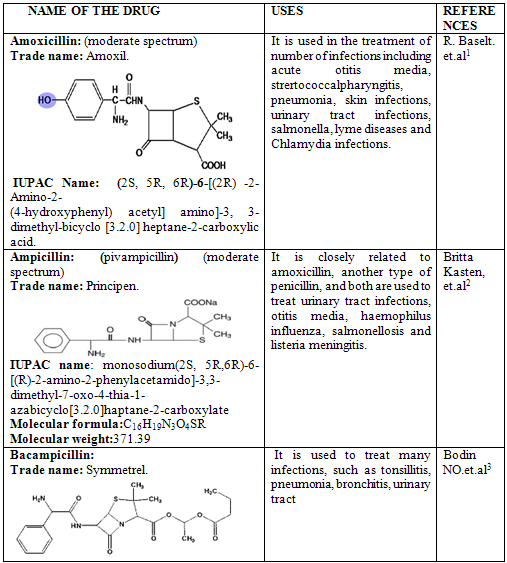

NOW YOU CAN ALSO PUBLISH YOUR ARTICLE ONLINE.
SUBMIT YOUR ARTICLE/PROJECT AT articles@pharmatutor.org
Subscribe to Pharmatutor Alerts by Email
FIND OUT MORE ARTICLES AT OUR DATABASE

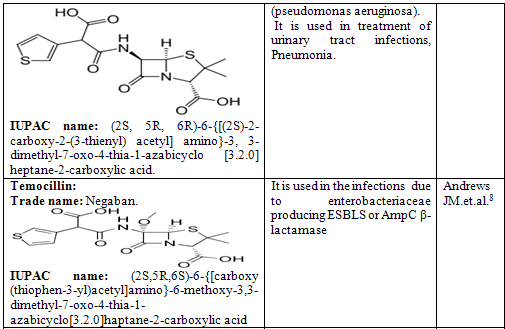

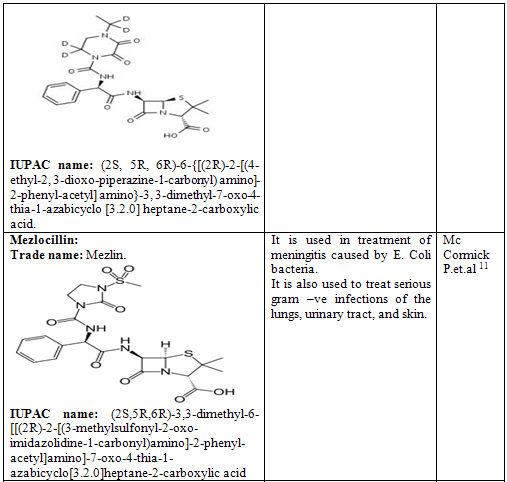
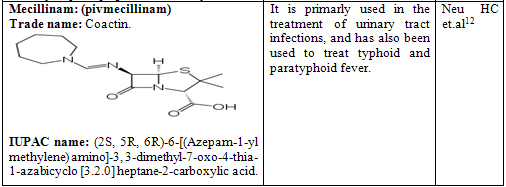
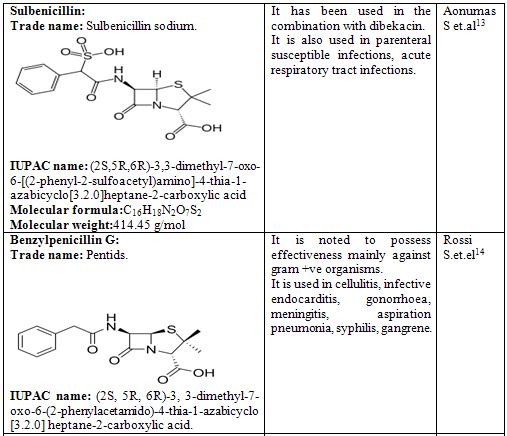
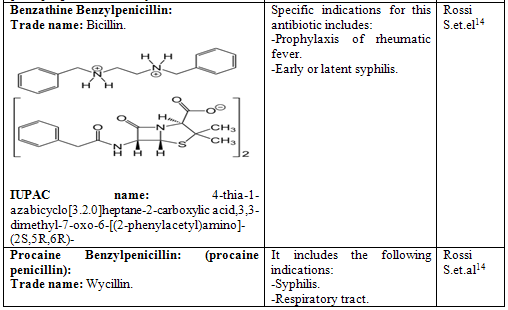

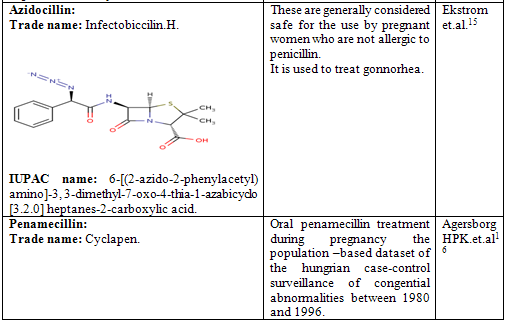
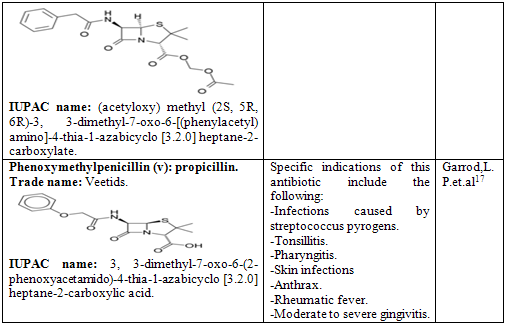
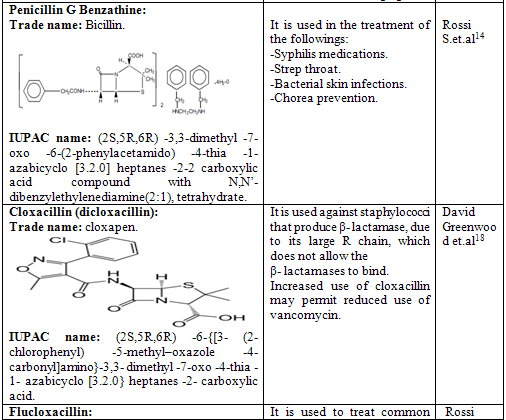
NOW YOU CAN ALSO PUBLISH YOUR ARTICLE ONLINE.
SUBMIT YOUR ARTICLE/PROJECT AT articles@pharmatutor.org
Subscribe to Pharmatutor Alerts by Email
FIND OUT MORE ARTICLES AT OUR DATABASE
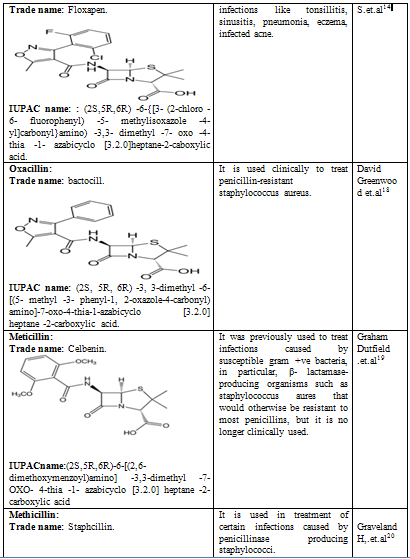

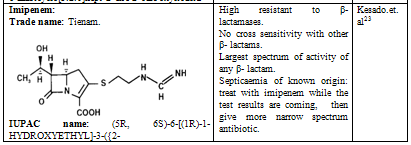

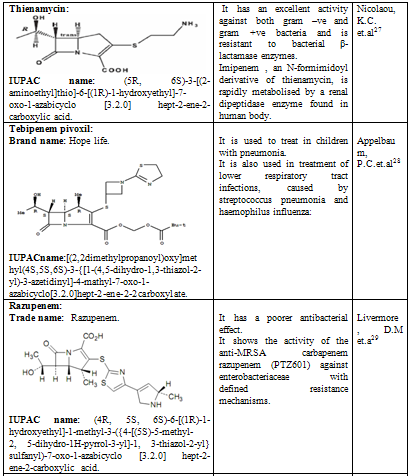
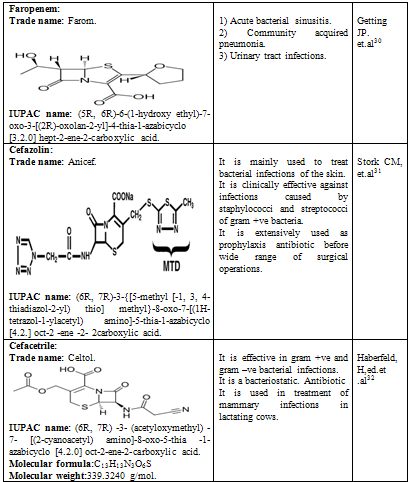
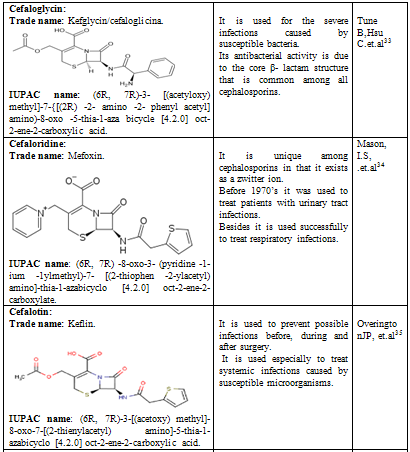
NOW YOU CAN ALSO PUBLISH YOUR ARTICLE ONLINE.
SUBMIT YOUR ARTICLE/PROJECT AT articles@pharmatutor.org
Subscribe to Pharmatutor Alerts by Email
FIND OUT MORE ARTICLES AT OUR DATABASE
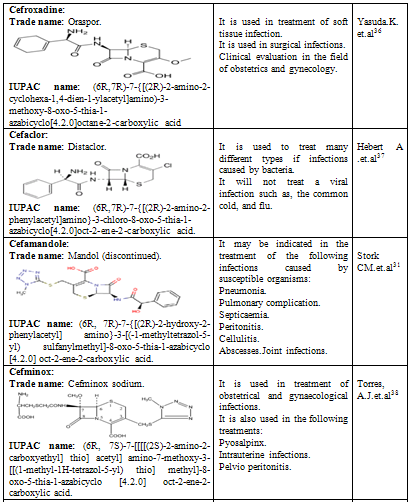
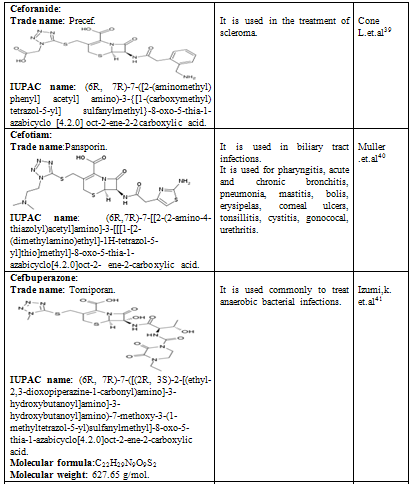
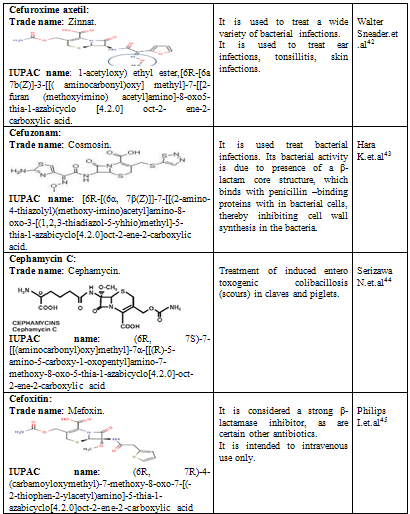

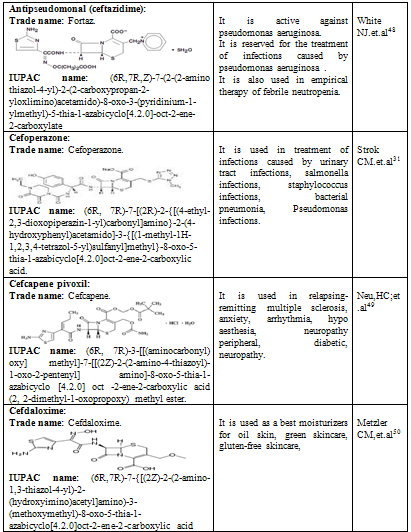
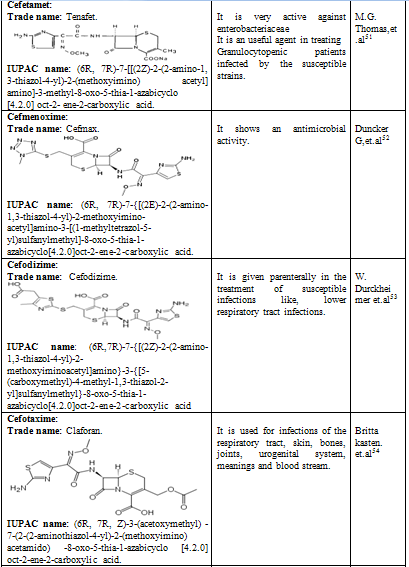
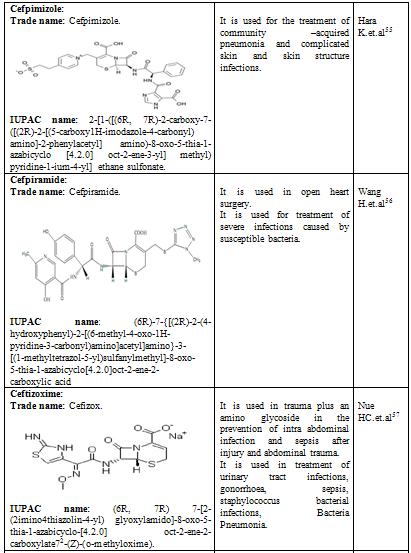
NOW YOU CAN ALSO PUBLISH YOUR ARTICLE ONLINE.
SUBMIT YOUR ARTICLE/PROJECT AT articles@pharmatutor.org
Subscribe to Pharmatutor Alerts by Email
FIND OUT MORE ARTICLES AT OUR DATABASE


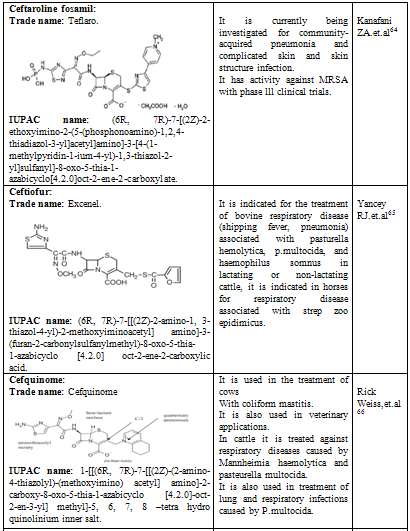

NOW YOU CAN ALSO PUBLISH YOUR ARTICLE ONLINE.
SUBMIT YOUR ARTICLE/PROJECT AT articles@pharmatutor.org
Subscribe to Pharmatutor Alerts by Email
FIND OUT MORE ARTICLES AT OUR DATABASE
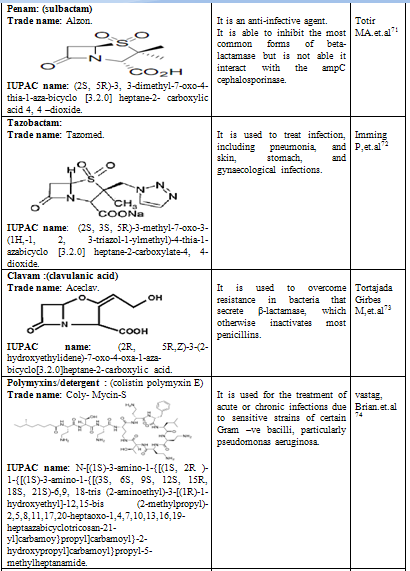

CONCLUSION:
Antibiotics(antimicrobial) are the substance produce by micro-organism,which selectively suppress the growth or kill other microorganism at very low concentration.These have the greatest contribution of the 20th century to therapeutics. Their advent changed the outlook of the physician about the power drugs can have on disease. Their importance is magnified in the developing countries,where infective diseases predominate. As a class they are on of the most frequently used as well as misused drugs. Antimicrobial drugs used are of so many kind according to their chemical nature. But out of them β-lactam containing drugs plays a important role in this particular area. It is active against gram +ve bacteria ,It is clinically used in veterinary medicines, treatment of scleroma, complex abdominal infections, pneumonia, urinarytract infections including kidney infection with septicaemia, It is also used in treatment of lung and respiratory infections caused by P.multocida and also it contribute to several uses as mentioned in the table above. The future of β- lactam containing drugs are most demanding for its diverse effect.
REFERENCES:
1) R. Baselt, Disposition of toxic drugs and chemicals in man, 8th edition, Biomedical publications, Foster City, CA, 2008, pp. 81-83.
2) Britta Kasten and Ralf Reski (1997): β- lactam antibiotics inhibit chloroplast division in a moss (Physcomitrella patens) but not in tomato (Lycopersicon esculentum). Journal of Plant Physiology 150, 137-140. [1]
3) Bodin NO, Ekstrom B, Forsgren U et.al. (November 1975). “Bacampicillin: A New Orally Well-Absorbed Derivative of Ampicillin”. Antimicrob Agents Chemother 8 (5): 518-25.
4) Sutherland R, Elson S, Croydon EA (1972). “Metampicillin. Antibacterial Activity and Absorption and Excretion in Man”. Chemotherapy 17 (3);145-60.
5) Schapiro RL, Newman A. Acute enterocolitis. A complication of antibiotic therapy. Radiology. 1973 Aug; 108 (2): 263-268.
6) Mombelli G (may 1981). “[Aminopenicillin: when, how, what kind?]” (in German). Schweiz Med Wochenschr 111 (18): 641-5.
7) Chambers HF, Sachdeva M, Kennedy S: Binding affinity for penicillin-binding protein 2a correlates with in vivo activity of beta-lactam antibiotics against methicillin-resistant Staphylococcus aureus.J infect Dis. 1990 sep; 162(3):705-10.
8) Andrews JM, Jevons G, Walker R, Ashby J, Fraise AP (July 2007). “Temocillin Susceptibility by BSAC methodology ” .J. Antimicrob. Chemother. 60(1):185-7.
9) In vitro and in vivo activity: G.K.Daikos et.al., curr. Chemother., proc. 10th int. Cong. Chemother., 1977 (Amer . soc. Microbiol., Washington, D,C., 1978) 1, pp 626-8.
10) Lau W, Mercer D, Itani K, et.al. (2006). “Randomized, open- label, comparative study of piperacillin-tazobacteram administered by continuous infusion for the treatment of hospitalized patients with complicated intra-abdominal infections” .Antimicrob Agents chemother 50 (11): 3556-61.
11) Mc Cormick P, Greenslade L, Kibbler C, Chin J, Burroughs A, Mcintyre N (1997). “ A prospective randomized trial of ceftazidime versus netilmicin plus mezlocillin in the empirical therapy of presumed sepsis in cirrhotic patients.” . Hepatology 25 (4): 833-6.
12) Neu HC (1985). “ Amdinocillin: a novel penicillin. Antibacterial activity, Pharmacology and Clinical use “.Pharmacotherapy 5 (1): 1-10.
13) Aonuma S, Ariji F, Oizumi K, Konno K (June 1987). “ Electron Microscopy of Pseudomonas aeruginosa treated with sulbenicillin and dibekacin” . Tohoku J. Exp. Med. 152 (2): 119-28.
14) Rossi S, editor, ed. (2006). Australian Medicines Handbook. Adelaide : Australian Medicines Handbook.
15) Ekstrom et.al., Acta Chem. Scand. 19,281 (1965). Pharmacology : Hanseen et .al., Antimicrob. Agents Chemother. 1967, 568.
16) Agersborg HPK; Batchelor, A: Cambridge, GW; Rule, AW (1966). “ THE PHARMACOLOGY OF PENEMECILLIN”. Brit. J. Pharmacol. 26(3): 649-55.
17) Garrod, L.P.(1960). “ Relative Antibacterial Activity of three Penicillins “. British Medical Journal (5172): 527-29.
18) David Greenwood (2008). Antimicrobial drugs: chronicle of a twentieth century medical triumph. Oxford University Press US. Pp.124
19) Graham Dutfield (30 July 2009). Intellectual property rights and the life science Industries: past, present and future. World Scientific .pp.140-.
20) Graveland H, Duim B, van Duijkeren E, Heederik D, Wagenaar Ja (December 2011).” Livestock- associated methicillin-resistant staphylococcus aureus in animals and humans”.Int.J.Med.Microbiol.301(8): 630-4.
21) Aldridge KE, Morice N, Schiro DD (April 1994). “ In vitro activity of biapenem (L-627), a new carbapenem, against anaerobes” . Antimicrob. Agents Chemother. 38 (4): 889-93
22) Livermore DM, Mushtaq S, Warner M (2005). “selectivity of ertapenem for pseudomonas aeruginosa mutants cross-resistant to other carbapenems”. J Antimicrob Chemother 55(3): 306-311.
23) Kesado, Tadataka; Hashizume, Terutaka; Asahi Yoshinari (1980). “ Antibacterial activities of a new stabilized thienamycin, N-formimidoyl thienamycin, in comparison with other antibiotics”. Antimicrobial agents and chemotherapy 17 (6): 912-7.
24) Margolin L. Impaired rehabilitation secondary to muscle weakness induced by meropenem . clin. Drug invest. 2004; 24 (1): 61-2.
25) Finch, Roger G. (2003). Antibiotic and chemotherapy : anti-infective agents and their use in therapy. Elsevier Health Sciences.pp.269
26) Janssen-ortho Inc. (September 1,2009)” doribax”.
27) Nicolaou, K,C;Sorensen, Erik (1996). Classics in total synthesis. VCH Publishers .pp.255,260.
28) Appelbaum, P.C. 1992. Antimicrobial resistance in streptococcus pneumonia: an overview. Clin. Infect. Dis. 15: 77-83.
29) Activity of the anti-MRSA carbapenem Razupenem (PTZ601) against Enterobacteriaceae with defined resistance mechanisms. Livermore, D.M; Mushtaq, S; Warner, M. J. Antimicrob. Chemother. (2009)
30) Getting JP, Crank CW, Philbrick AH (January 2008). : Faropenem medoxomil” . Ann Pharmacother 42 (1): 80-90.
31) Stork CM (2006). “ Antibiotics, antifungals, and antivirals”. In Neison LH, Flomenbaum N, Goldfrank LR, Hoffman RL, Howland MD, Lewin NA (eds.). Goldfrank’s toxicologic emergencies. New York: Mc Graw-Hill. Pp.847.
32) Haberfeld, H,ed.(2007) (in German). Austria-codex (2007/2008ed.). Vienna: Osterreichischer Apothekerverlag.
33) Tune B Hsu C (1990). “The renal mitochondrial toxicity of β- lactam antibiotics: in vitro effects of cephaloglycin and imipenem .”. J Amsoc Nephrol 1 (5):815-21
34) Mason, I.S,, Kietzmann, M; Cephalosporins- pharmalogical basis of clinical use in veterinary dermatology 1999,10.187-192.
35) Overington JP, Al-Lazikani B, Hopkins AL: How many drug targets are there ? Nat Rev Drug Discov. 2006 Dec ; 5 (12):993-6.
36) Yasuda K, Kurashige S, Mitsuhashi S (July 1980). “Cefroxadine (CGP-9000), AN ORALLY ACTIVE CEPHALOSPORIN” . Antimicrobial agents and chemotherapy 18 (1): 105-10.
37) Hebert A, Sigman E, Levy M (1991). “Serum sickness-like reactions from Cefaclor in children.” J Am Acad Dermatol 25 (5 pt 1): 805-8.
38) Torres A, J.; Vallandares, L.D.; Jover, J.M.; Sanchez-pernaute, A.; Frias ,J.; carcas,A. J.; Coronel, P.; Rodenas, E.et.al.(2000). “ Cefminox versus metronidazole plus gentamicin intra-abdominal infections: A prospective randomized controlled clinical trial “. Infections 28 (5): 318-322.
39) Cone L, Barton S, Woodard D (1987). “Treatment of scleroma with ceforanide.” Arch otolaryngol Head Neck Surg 113 (4): 374-6.
40) Muller R, Bottger C, Wichmann G (2003). “Suitability of cefotiam and cefuroxime axetil for the perioperative short-term prophylaxis in tonsillectomy patients.” Arzneimmitelforschung 53 (2): 126-32.
41) Izumi, K.; Kawazoe, K.; Mikamo, H.; Ito, K .; Tamaya, T. (1995). “In vivo bacterial regrowth-inhibition effect of cefbuperazone and amikacin in puerperal uterine cavity”. Journal of chemotherapy (Florence, Italy) 7 Suppl 4: 173-176.
42) Walter Sneader. Drug Discovery: A History . John Wiley, Chichester, UK.
43) Hara K, Matsumoto F (December 1987). “[New Antimicrobial Agent Series XXVlll: Cefuzonam]” (In Japanese). Jpn J Antibiot 40 (12): 1953-63.
44) Serizawa N, Nakagawa K, Haneishi T, Kamimura S, Naito A (1980) Enzymatic conversion of cephamycin C by D-amino acid oxidase from Trigonopsis variabilis. The Journal of antibiotics 33, 585-590
45) Philips I, Shannon K (1993). “ Importance of beta- lactamase induction”. Eur J Clin Microbiol Infect Dis 12 suppl 1 : s19-26.
46) Biedenbach DJ, Jones RN (February 1994). “ Predictive accuracy of disk diffusion test for Proteus vulgaris and Providencia species against five newer orally administered cephalosporins. Cefdinir, cefetamet, cefprozil, cefuroxime. And loracarbef” .J. Clin. Microbiol. 32 (2): 529-62.
47) Gladwin , Mark (2007). Clinical Microbiology Made Ridiculously Simple 4th ed.. Miami, FL: MedMaster. Inc.. pp.67.
48) White NJ (2003). “Melioidosis”. Lancet 361 (9370): 1715-722.doi:10.1016/s0140-6736 (03)13374-0.
49) Neu,HC;et.al.: Antimicrob.Agents Chemother., 36,1336(1992), Ishikura, K.,et.al.:J. Antibiot., 47,466 (1994)
50) Metzler CM, DeHaan RM. Susceptibility tests of anaerobic bacteria: statistical and clinical considerations. J. Infect Dis. 1974 Dec; 130 (6): 588-594.
51) M.G. Thomas, S.D.R.Lang, Antimicrob. Agents Chemother. 29,945(1986). HPLC determ in biological fluids : R. Wyss, F. Bucheli, J. Chromatogr. 430, 81 (1988).
52) Duncker G, Reich U, Krausse R(1994). “ cefmenoxime in corneal organ culture .”. Opthalmologica 208 (5): 262-6.
53) Third generation cephalosporins antibiotic with immunomodulating activity: derivative of cefotaxime, q.v. prepn: BE 865632; W. Durckheimer et.al; US 4278793 (1978, 1981 both to Hoechst AG); and antibacterial activity : J. Blumbach et.al; J. Antibiot. 40, 29 (1987).
54) Britta Kasten und Ralf Reski (1997): β- lactam antibiotics inhibit chloroplast division in a moss (Physcomitrella patens ) but not in tomato ( Lycopersicon esculentum). Journal of Plant Physiology 150, 137-140.
55) Hara K, Shimada J (June1987). “[New antimicrobial agent series XXI: cefpimizole]” (in Japanese). Jpn J Antibiot 40 (6): 1108-22.
56) Wang H.Yu Y, Xie X, Wang C, Zhang Y, Yuan Y, Zhang X, Liu J, Wang P, Chen M (2000). “ In –vitro antibacterial activities against 440 clinical isolates in china” . J. Infect Chemother 6 (2): 81-85.
57) Fu KP, Nue HC, Antibacterial activity of ceftizoxime, a β- lactamase- stable cephalosporin, Antimicrob Agents Chemother. 1980 Apr; 17 (4): 583-590.
58) Ito M, Ishigami T(1991). “The meaning of the development of flomoxef and chemical experience in Japan”. Infection 19 suppl 5: S253-7.
59) Weitekamp MR, Aber RC (1983). “Prolonged bleeding times and bleeding diathesis associated with moxalactam administration”. JAMA 249 (1): 69-71.doi:10.1001/jama.249.1.69.
60) Chapman TM, Perry CM (2003). “cefepime : a review of its use in the management of hospitalized patients with pneumonia”. Am J Respir Med 2 (1): 75-107.
61) Vogelman B, Gudmundsson S, Turnidge J, Leggett J, Craig WA. In vivo postantibiotic effect in a thigh infection in neutropenic mice.J infect Dis, 1988 Feb; 157 (2): 287-298
62) Rick Weiss, “FDA Rules Override Warnings about Drug”. The Washington Post, March 4, 2007, sec.A01.
63) Kollef MH (December 2009). “New antimicrobial agents for methicillin-resistant staphylococcus aureus”. Crit Care Resusc 11(4): 282-6
64) Kanafani ZA, Corey GR (February 2008). “Ceftaroline fosamil, a cephalosporin derivatives for the potential treatment of MRSA infections”. Current opinion in investigational Drugs (London, England: 2009) 9 (2):201-9.
65) Yancey RJ, Kinney ML, Robets BJ, Goodenough KR, Hamel JC, Ford CW (1987). “cetiofur sodium, a broad- spectrum cephalosporins: evaluation in vitro and in vivo in mice”. Am.J. Vet. Res. 48 (7): 1050-3.
66) Rick Weiss, “FDA Rules Override Warnings about Drug”. The Washington Post, March 4, 2007, sec.A01.
67) Mosby’s Drug Consult 2006(16 ed.). Mosby, Inc .. 2006.
68) Fuschs PC, Jones RN, Barry AL (March 1988). “In vitro antimicrobial activity of tigemonam, a new orally administered monobactam”. Antimicrob. Agents Chemother. 32 (3): 346-9.
69) McNulty,C.A.; Garden, G.M; Ashby,J.; Wise,R.(1985). “Pharmacokinetics and tissue penetration of carumonam, a new synthetic monobactam”.Antimicrobial agents and chemotherapy 28(3):425-427.
70) Biosynthetic studies of A:J. Hosada et.al;Agric.Biol.Chem.41,2007(1977); C.A. Townsend et.al; J.Am .Chem .soc.105,919(1983).
71) Totir MA, Helfand MS, Carey MP, et al.(August 2007). “Sulbactam forms only minimal amounts of irreversible acrylate-enzyme with SHV-1 β-lactamase”. Biochemistry 46 (31): 8980-7.
72) Imming P, Sinning C; Meyer A: Drugs , their targets and the nature and number of drug targets. Nat Rev Drug Discov. 2006 oct; 5 (10): 821-34.
73) Tortajada Girbes M, Ferrer Franco A, Gracia Antequera M, clement Paredes A, Garcia Munoz E, Tallon Guerola M, (2008). “Hypersensitivity to clavulanic acid in children”. Allergol immunopathol (Madr) 36 (5):308-10.doi:10.1016/s0301-0546 (08)75228-5.
74) Vastag, Brian (2012), “NIH Superbug Outbreak Shows Lack of Antobiotics”. The Washington post, Saturday, 25 August 2012; pg A2.
75) Tally FP, DeBruin MF (October 2000). “Development of daptomycin for gram-positive infections “.J Antimicrob Chemother .46 (4): 523-6.doi.10.1093/jac/46.4.523
76) Kessler,N.et.al (2004). “The Linear Pentadecapeptide Gramicidin is assembled by Four Multimodular Nonribosomal Peptide Synthetases That Comprise 16 Modulas with 56 catalytic Domains”. The Journal of Biological Chemistry 279 (9): 7413-7419.
77) Levine , D. (2006). “Vancomycin: A History”. Clin Infect Dis 42: S5-S12.
NOW YOU CAN ALSO PUBLISH YOUR ARTICLE ONLINE.
SUBMIT YOUR ARTICLE/PROJECT AT articles@pharmatutor.org
Subscribe to Pharmatutor Alerts by Email
FIND OUT MORE ARTICLES AT OUR DATABASE










